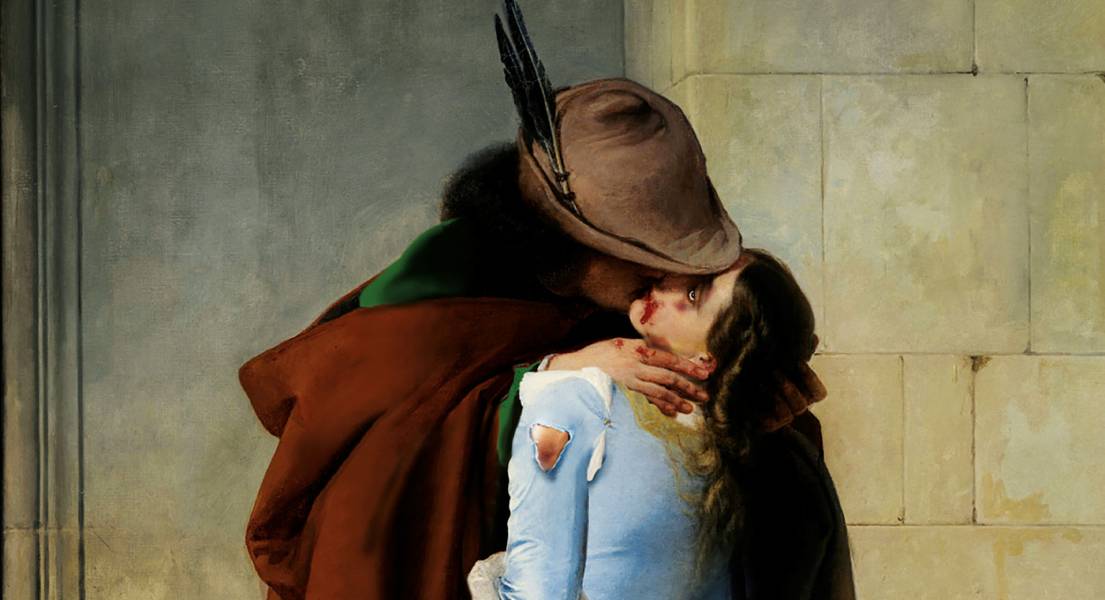He turned the docile MargeSimpsons in an anti-Islamic revolutionary fair which, to support feminist ideals, cuts off its hair cleanly. She has filled cartoon heroines with bruises, because sometimes gender-based violence is so powerful that it crosses the barrier of reality and infects dreams. You have transformed the Disney princesses into proud spokespersons for disability. aleXsandro Palombo he shakes consciences through his irreverent and committed art and with his murals scattered throughout the streets of Milan he forces us to reflect on the social injustices and distortions of our time.
Interview with aleXsandro Palombo
What is the role of art?
«Art allows people to dig into their unconscious to seek amazement, recklessness, courage, beauty and truth. We live in a society where, absurdly, all this hyper-connection is leading us towards a mass control system that tends to homogenize everything and, little by little, deprives us of our freedom. Art is one of the few means of expression that can still help us reflect and stay anchored to freedom».
Why did you choose to bring your art to the streets, outside the institutional circuit of galleries?
“The road is just a means like so many others. I’ve always been an outsider and I’ve never set context limits. In life I have had the opportunity to express my creativity in various environments, vision and experimentation are the basis of everything. The road remains the last freest place there is: it is an open-air gallery without filters».
Why do you address social issues in your works?
«I deal with these issues for my life. It is the human baggage that I have always carried with me and that tends to re-emerge. Social is something that has dragged me along since I was a kid, my first experiences in the Red Cross, I was at the forefront of humanitarian aid when there was the mass landing of Albanian refugees who arrived in Puglia, then a few years around the world in the Navy between humanitarian missions and war missions, and much more. I have seen and touched a lot of suffering: that is my basis».
Does the sensitivity towards some issues derive from the fact that you have been the victim of some form of violence, physical or psychological?
«Dealing with certain issues is a reaction to my experiences and life’s adversities and it’s not easy to move within certain contexts; life has led me to react even to important traumas and art has been the best cure for me, a therapy and in some ways a salvation».
Have you ever anticipated with your work a theme that later became the object of social protest?
«I was among the forerunners on the issues of inclusion and diversity, in raising awareness of social issues that many years before were treated in a marginal way and, thanks to the global impact they have had, many of my social campaigns have become mainstream. I dealt with anorexia in 1998, when the problem was still a taboo and in fashion it couldn’t even be named: I brought it to the attention of public opinion and I challenged systems, for this I paid a price».
Tell us better.
«The Break The Silence series with celebrities victims of violence, from Kim Kardashian to Gwyneth Paltrow up to Angelina Jolie, has had a huge impact on the media around the world, opening up to an unprecedented debate. It was an important means of raising awareness towards the star system, inviting them to break the silence and take a stand on the issue. Until then, celebrities saw the problem as something to hide for career and image reasons. That series of works was revealing.
How?
«He paved the way for the Me Too where Gwyneth Paltrow and Angelina Jolie also exposed themselves in the Weinstein case. With Angelina Jolie’s staff there was the opportunity to have a discussion on my series of works, because Brad Pitt did not take it well at all: he was not happy to see everywhere the image of Angelina with a swollen face, although she was not reality but only a work of art. On the contrary, Angelina understood the importance of those works».
Other series of works that have raised the debate?
«In 2014 I made Do you still like us? the series of works that portrays disabled Disney princesses, against gender stereotypes and to raise the issue of inclusion and diversity in a period in which the topic was treated little and marginally. A work that paved the way for social debate and had the ability to undermine gender stereotypes and quickly become a powerful message of inclusiveness.
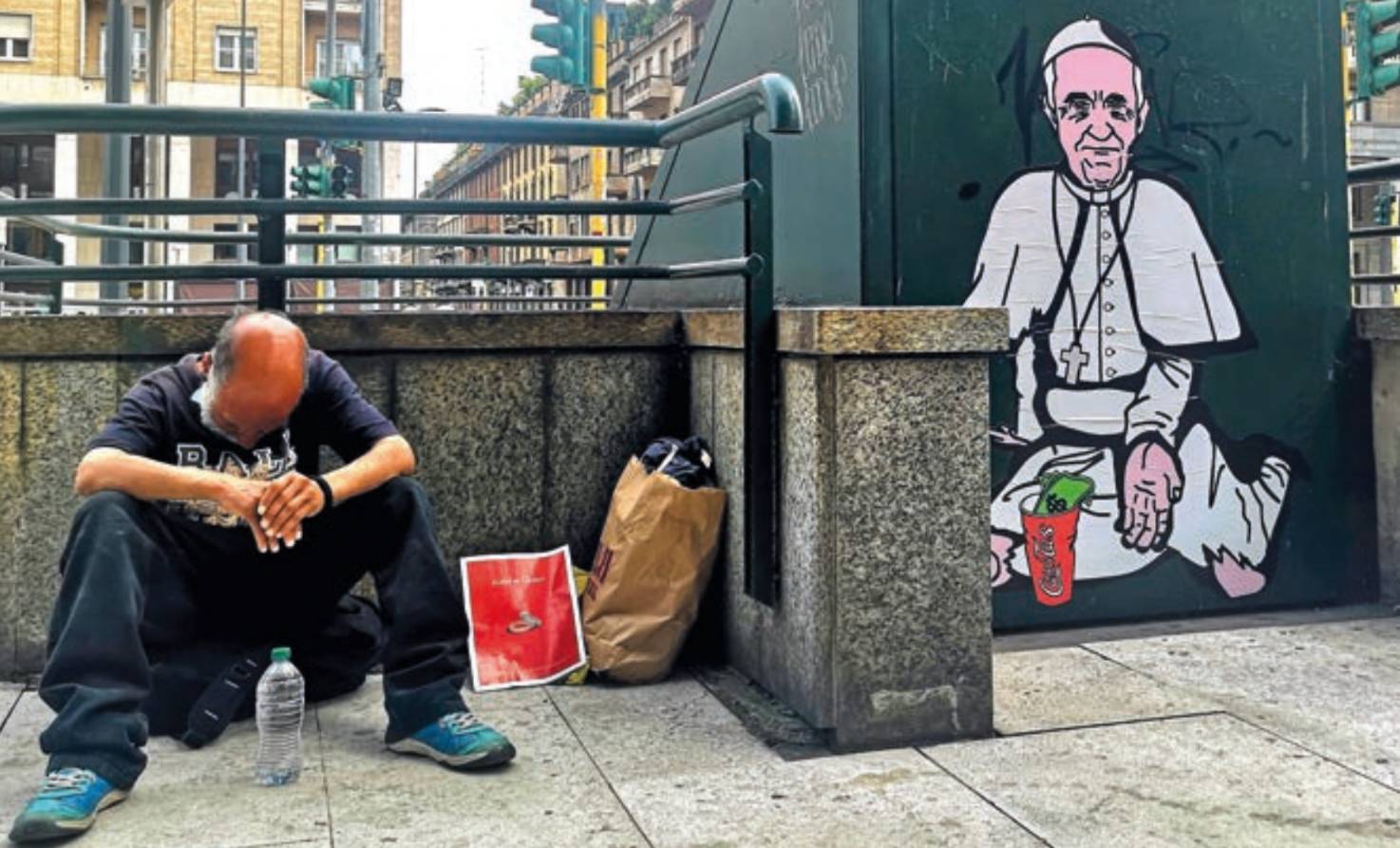
As?
«Over the years this series of works has pushed Disney to implement important diversity policies so as to start creating new characters farther from stereotypes and closer to reality. Today we talk about domestic violence as never before, when I began to create my series of works on gender-based violence, the newspapers spoke very little about it and there wasn’t a strong collective awareness».
What is your opinion on the media?
«Information is a public good that must be protected and supported, in this historical moment I perceive it as increasingly fragile, freedom of the press is subjected to many pressures and many publishers prefer to give space to speed at the expense of insights and this leads to a cultural impoverishment of society. If the press suffers from little freedom, art remains one of the few means of expression where one can still hope to come across the truth».
Why juxtapose pop characters, such as Disney princesses who in the collective imagination belong to the world of childhood, with the violence in Iran or the Shoah?
«My works are an anti-social anesthetic against fiction and stereotypes, they tend to subvert the toxic narration of many iconic figures of the pop imaginary to prompt us to reflect, they take shape in an atmosphere of freedom, real and dystopian, where the spectator becomes the explorer of both the fairy tale and reality».
What are the risks for an artist who denounces?
«It depends on what he denounces and the impact it has. When you use a very corrosive visual language then the risk becomes high and intimidating reactions come quickly, you always have to keep going straight and always be brave. Authentic artists don’t censor themselves, mediocre ones do».
Have you ever received threats or pressure of any kind for one of your works?
«A lot, there is a much richer behind-the-scenes experience than what can be seen on stage, but I don’t emphasize these situations so as not to take away space from the work and remain free to create without ever wearing blinders».
What advice would you give to an emerging artist?
«I’m not the right person to give advice, I just believe that each of us is a unique being capable of expressing ourselves for what we are. The most important thing is to be free and authentic».
From the catwalks to the streets: the life and works of aleXsandro Palombo
Katia Del Savio
For several years he has decided to remain in the shadows. Apart from a few rare interviews, never on video or on the radio, aleXsandro Palombo he much prefers to leave the “word” to his works of social art, some of which have become part of the permanent collections of authoritative international institutions. From the 90s until 2005 Palombo was an important creative of international fashion, artist, illustrator and designer, collaborating with the most important magazines in the world, from Vogue to Harper’s Bazaar, up to Marie Claire. In 1998 Stern magazine compared him to Gianni Versace for his color sense.
Originally from Salento, he moved to Milan to study at theMarangoni Institute in the late 80s. From that moment the Milanese city adopted him. His artistic career is centered on denouncing and raising public awareness of important social issues. His works are easily recognizable thanks to the style that draws inspiration from pop culture and the reworking of cartoon characters. They are satirical, thoughtful and irreverent, focusing on inequality, inclusion, diversity and human rights.
The theme of discrimination and violence against women is central to her artistic research. In this sense, in addition to the works with MargeSimpsonswe mention the series of seven posters entitled Just because I am a woman – which portray international female politicians such as Angela Merkel and Hillary Clinton with a swollen face – which first appeared in Milan and then abroad in 2019 and which have now become part of the Mad (Decorative Arts Museum) of the Louvre in Paris.
In June 2020, those passing through Corso Venezia were able to cross paths on the panels of a construction site Who is next?: the black Simpsons in homage to George Floyd, the African American killed by the US police, a painful event from which the Black Lives Matters movement was born. Palombo’s last Milanese work in chronological order is Save 41 bis, linked to the debate on hard prison resulting from the story of the anarchist Alfredo Cospito.
aleXsandro Palombo, the chronicle of his works
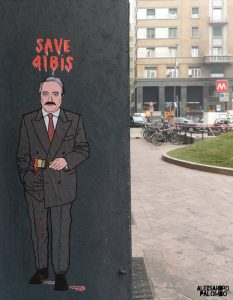 February 22, 2023
February 22, 2023
Save 41 bis
Piazza San Babila
Giovanni Falcone is portrayed with a dripping brush in his hand after having painted the inscription that gives the title to the work in the days when the debate on the 41bis is ignited.
February 4, 2023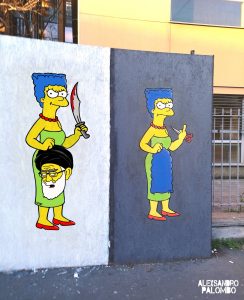
The final cut
Via Monte Rosa
In front of the Iranian consulate, Marge Simpson holds the severed head of Ali Khameinei, the supreme leader of the Iranian regime, in her hand after cutting it off with a machete.
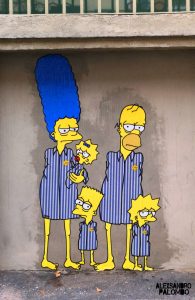 January 26, 2023
January 26, 2023
Platform 21 The Simpsons deported
Central Station
For Remembrance Day on the walls of the Holocaust Memorial the Simpsons appear departing from Platform 21 and with the striped pajamas of the concentration camps.
October 19, 2022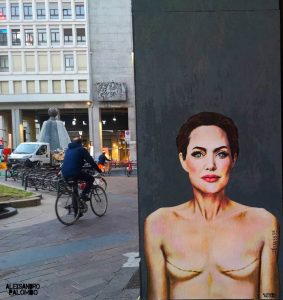
Love yourself
Piazza San Babila
Angelina Jolie shows signs of mastectomy on World Breast Cancer Day: a message to celebrate the strength and courage of women.
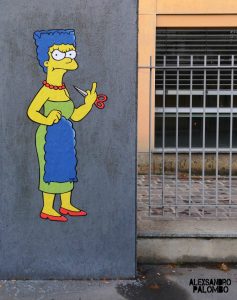 October 11, 2022
October 11, 2022
The Cut 2
Via Monte Rosa
After the previous mural was deleted, Palombo redraws Marge Simpson as she gets a haircut in front of the Iranian consulate. This time he raises his middle finger.
October 6, 2022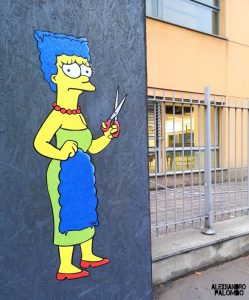
The Cut
Via Monte Rosa
In the days in which the protests for the death of the young Iranian Masha Amini are inflamed, Marge Simpson appears in front of the Iranian consulate after having cut off her blue hair.
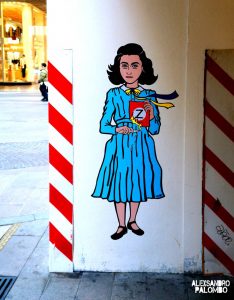 March 24, 2022
March 24, 2022
Remember
via Pio IV
One month after the outbreak of war in Ukraine, Anne Frank is represented with a yellow-blue ribbon around her neck while a sheet with a Z, symbol of the Russian troops, is burning with a candle.
March 8, 2022
The abuse
via Brera
On International Women’s Day Palombo rereads Il Bacio, a painting by Francesco Hayez preserved in the nearby Pinacoteca di Brera, transforming the scene into an act of violence.
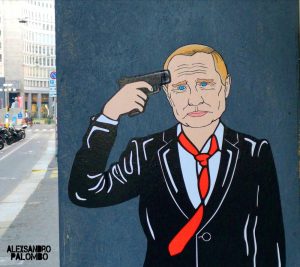 March 3, 2022
March 3, 2022
The suicide of the tsar
downtown streets
A few days after the outbreak of war in Ukraine, the figure of Putin appears in various streets in the center while pointing a gun at his head. The works are immediately removed.
March 8, 2021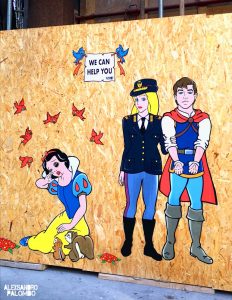
We can help you
via Torino and via Tommaso Grossi
Disney princesses victims of violence are rescued by policemen and carabinieri who arrest abusive “princes” on World Women’s Day.
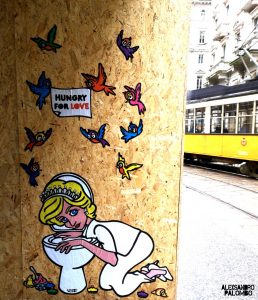 February 1, 2021
February 1, 2021
Once upon a time Lady Diana
Cordusio area
Lady Diana is portrayed as if she were a “bulimic and rebellious” Disney princess, leaning over the toilet or screaming that Prince Charming does not exist.
November 2019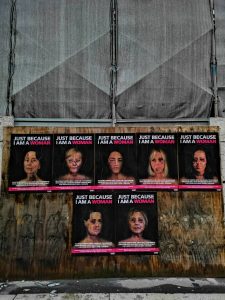
Just because I am a woman
downtown streets
Famous international politicians with swollen faces to commemorate the Day against violence against women, a series later acquired by the Louvre Museum of Decorative Arts.

